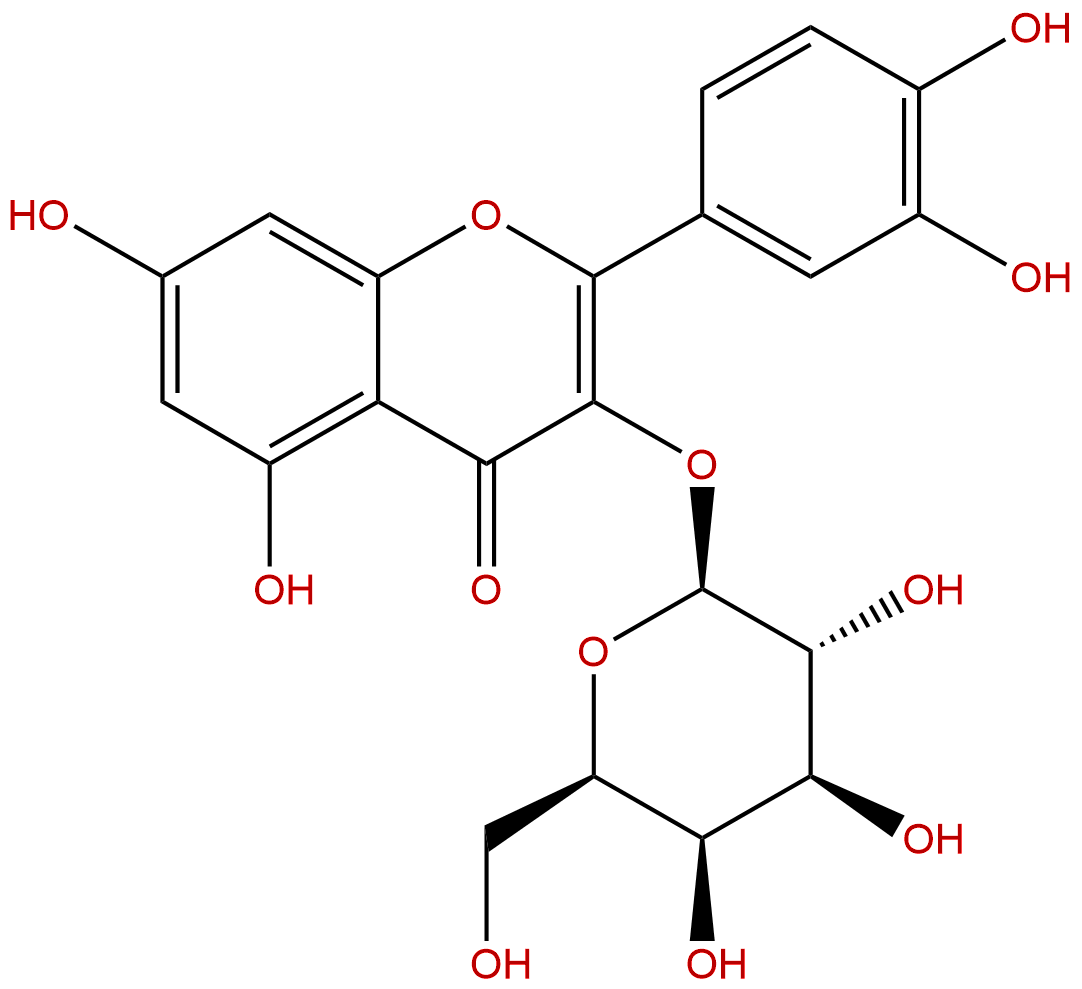
HyperosideCAS No.:482-36-0
|
||||||||||
 |
|
|
||||||||

| Catalogue No.: | BP0753 |
| Formula: | C21H20O12 |
| Mol Weight: | 464.379 |
Product name: Hyperoside
Synonym name: Quercetin 3-galactoside; Hyperin
Catalogue No.: BP0753
Cas No.: 482-36-0
Formula: C21H20O12
Mol Weight: 464.379
Botanical Source: Occurs widely in plants, e.g. in apple peel, quince peel, Crataegus laevigata (hawthorn), Hypericum perforatum (St John's wort), Betula, Juglans and many other spp. Present in almost all of 60 investigated spp. in the Polygonaceae (Hnsel et al, 1954)
Physical Description: Yellow powder
Type of Compound: Flavonoids
Purity: 95%~99%
Analysis Method: HPLC-DAD or/and HPLC-ELSD
Identification Method: Mass, NMR
Packing: Brown vial or HDPE plastic bottle
Storage: Store in a well closed container, protected from air and light. Put into refrigerate or freeze for long term storage.
Whenever possible, you should prepare and use solutions on the same day. However, if you need to make up stock solutions in advance, we recommend that you store the solution as aliquots in tightly sealed vials at -20℃. Generally, these will be useable for up to two weeks.
The product could be supplied from milligrams to grams, up to kilograms
Inquire for bulk scale.
Descriptions:
Hyperoside, a flavonoid glycoside isolated from Artemisia capillaris, has protective effects against CCl4-induced acute liver injury, and this protection is likely due to enhancement of the antioxidative defense system and suppression of the inflammatory response.[1]
Hyperoside can protect Aβ-induced primary cultured cortical neurons via PI3K/Akt/Bad/Bcl XL -regulated mitochondrial apoptotic pathway, and they raise the possibility that hyperoside could be developed into a clinically valuable treatment for Alzheimer's disease and other neuronal degenerative diseases associated with mitochondrial dysfunction.[2]
Hyperoside is a strong inhibitor of HBsAg and HBeAgsecretion in 2.2.15 cells and DHBV-DNA levels in the HBV-infected duck model.[3]
Hyperoside isolated from Camptotheca acuminata, has antifungal activity, may serve as leads for the development of fungicides.[4]
Hyperoside has cytoprotective effects against hydrogen peroxide (H2O2)-induced cell damage by scavenging intracellular ROS and enhancing antioxidant enzyme activity, and protects HUVECs against H(2)O(2) damage, at least partially, by activating the ERK signaling pathway. [5,6]
Hyperoside has a variety of pharmacological effects including anti-viral, anti-oxidative, and anti-apoptotic activities and it has anti-Inflammatory activity through the suppression of nuclear factor-κB activation in mouse peritoneal macrophages.[7]
References:
[1] Choi J H, Kim D W, Yun N, et al. J Nat Prod, 2011, 74(5):1055-60.
[2] Zeng K W, Wang X M, Ko H, et al. Eur J Pharmacol, 2011, 672(1-3):45-55.
[3] WU, Lin‐lin, YANG, Xin‐bo, HUANG, Zheng‐ming, et al. Acta Pharmacol Sin, 2007, 28(3):404-9.
[4] Li S, Zhang Z, Cain A, et al. J Agrl Food Chem, 2005, 53(1):32-7.
[5] Mei J P, Kang K A, Rui Z, et al. BBA- Biomembranes , 2008, 1780(12):1448-57.
[6] Li Z L, Liu J C, Hu J, et al. J Ethnopharmacol, 2012, 139(139):388-94.
[7] SuJin Kim, JaeYoung Um, SeungHeon Hong, et al. Am J Chinese Med, 2012, 39(1):171-81.
[8] Zhou C L, Sun L L, Kai-Shun B I. Chinese J Pharm Analysis, 2009, 25(15):6760-71.
HPLC of Hyperoside
